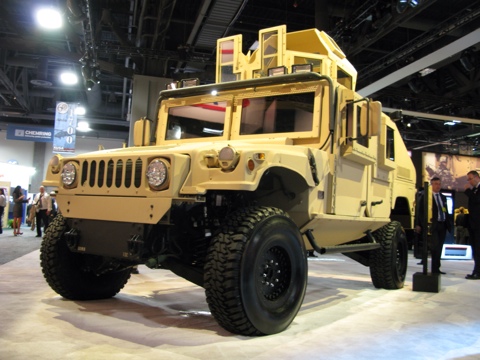
Among the heavier tactical vehicles on display were new versions of the BAE Systems’ Caiman Multi-Terrain Vehicle (MTV), configured to support Command and Control On-the-Move (C2OTM) assignments and ambulatory operations. Oshkosh displayed the latest reconnaissance version of the MRAP All Terrain Vehicle (MATV) . This vehicle carries crew of six plus gunner. The recce variant is equipped with mission specific technologies designed for missions such as route, zone and area reconnaissance. Recent models introduced with the M-ATV family of vehicles also includes SOCOM, Utility and Ambulance variants.
As the U.S. Army establishes its right mix of vehicles across the light, medium, and heavy vehicle fleets, new acquisition programs and recapitalization (recap) programs are weighed, assessing a cost effective mix that could meet the services’ planned budget cuts. As light vehicles are concerned, the army is still moving on two parallel paths,acquisition long term strategy developing the joint light tactical vehicle (JLTV) while pursuing low-cost recap of existing High Mobility Multipurpose Wheeled Vehicle (HMMWV) for the near term.
Several companies at AUSA are addressing the planned HMMWv Recap opportunity, among them BAE Systems and Oshkosh. BAE is offering the application of it’s ‘Integrated Smart V’ (ISV) program coupled with lightweight monocoque V-hull and mine protection improving survivability through relatively cost high investment in modernizing the fleet of high-mobility multipurpose vehicles expected to remain in service for the long term. Oshkosh is also seeking HMMWV recap opportunities, offering the TAK-4 independent suspension for improved mobility. the new suspension also contributes to increased payload capacity needed for the survivability enhancement. In addition to its advanced suspension, Oshkosh incorporates a V-shaped hull and engine and powertrain upgrades to improve soldier survivability as well as off-road mobility and payload capacity.
AM General also displays he an armored HMMWV variants designed in association with Plasan. Unlike other upgrade designs that use monocoque capsules, Plasan designed the vehicle with a ‘kitted armor’, which does away with unused structures and material, therefore reducing the weight of the protected vehicle. As many of the components previously spliced in the center body are now moved from the protected cabin, significant weight sis offloaded from the frontal wheels and moved back, and well below the axles’ load level, enabling the armor protected vehicle to demonstrate very high protection while retaining the efficient off road mobility of early HMMWVs.





















